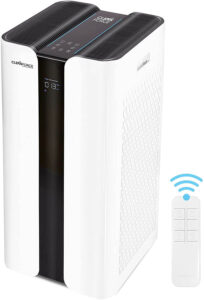Volatile organic compounds—or VOCs—are common indoor air pollutants from household products like cleaning supplies and building materials. They can cause health issues when concentrations are high enough. We're here to answer your questions about VOCs: what they are, how they affect your health, where they come from, and how to remove them.
What Are VOCs?
SafeWise experts have years of firsthand experience testing the products we recommend. Learn how we test and review.
Video: How Do I Test Air Quality in My Home?
Subscribe to our YouTube channel and learn how to protect your home, loved ones and, belongings.
What are volatile organic compounds?
At the most basic level, a volatile organic compound is a natural or artificial carbon compound with a low boiling point.1 This means that VOCs find their way into the air easily by off-gassing from a product or substance that contains them.
While you can find VOCs in the air everywhere—indoors and outdoors—they tend to concentrate inside buildings due to reduced ventilation.
Here are a few of the most common VOCs that contribute to indoor air pollution:2
- Benzene
- Ethylene glycol
- Formaldehyde
- Methylene chloride
- Tetrachloroethylene
- Toluene
- Xylene
- 1,3-butadiene
We realize that a list of VOCs probably doesn't do you much good, but these compounds are surprisingly common in homes, so let's explore the sources of VOCs in buildings.
Where do VOCs come from?
Many household products that we use to build, clean, and furnish our homes can off-gas VOCs into the air over time. You can find VOCs in all of these household products, furnishings, and activities:2, 3, 4
- Paints, stains, finishes, varnishes, adhesives, paint strippers, and other solvents
- Cleaning products, air fresheners, and disinfectants
- New rugs, carpets, wood floors, and vinyl floors
- New and reupholstered furniture
- Gasoline and other fossil fuels
- Dry-cleaned clothing
- Aerosol sprays
- Cosmetics
- Pesticides
- Smoking
- Cooking
- Burning wood
Considering how many VOC emission sources are in every home, it's no wonder that VOC concentration can increase over time.
According to the Environmental Protection Agency, "Studies have found that levels of several organics average 2 to 5 times higher indoors than outdoors. During and for several hours immediately after certain activities, such as paint stripping, levels may be 1,000 times background outdoor levels."
What are the health effects of VOCs?
In high concentrations, VOC exposure can cause a range of symptoms and health problems:4
Short-term exposure
- Eye, nose, and throat irritation
- Headaches, nausea, dizziness, and loss of coordination
- Allergic skin reaction
Long-term exposure
- Liver, kidney, and nervous system damage
- Cancer
Exposure to VOCs affects children and the elderly more than the average adult and can worsen the symptoms of asthma and other respiratory conditions.2 Despite all we know—there are so many kinds of VOCs that the EPA says "not much is known about what health effects occur from the levels of organics usually found in homes."4
How can I lower VOCs in my house?
The most effective way to improve air quality in your home is to remove pollutants at the source when possible.
While an air purifier with an activated carbon filter—like the CleanForce Mega1000—is a great way to clean the air, it won't work as well if VOCs and other airborne pollutants can replenish themselves.
Here are some tips for cutting VOC levels in your home:
- Use as much ventilation as possible when working indoors with products that include VOCs.4
- Use equipment like gloves, goggles, and respirators to protect yourself.
- Take smaller, portable projects outside to fresh air for maximum ventilation.
- Follow the manufacturer's directions when using household chemicals.4
- When possible, don't store extra paint, adhesives, fuels, solvents, cleansers, or other sources in your home after a project.2
- Keep organic chemicals in your garage or shed.
- Don't continue to store chemicals longer than you need them.
- Check with your city or town to learn where and when to dispose of unused chemicals and hazardous substances.
- Open doors and windows occasionally to help remove VOCs that off-gas from furniture and building materials, especially in new homes.2
- Opening windows during mild weather won't affect your heating and cooling bills as much.
- Mild weather is also a great time for your next remodeling project.
- Reduce your home's temperature and humidity when possible to slow down off-gassing.2
- Use chemicals and materials with low VOC content.
- Use an air quality monitor like uHoo or Airthings to keep tabs on VOC levels at home.
- Consider switching to an electric stove if you use gas. Here's some more information on why switching from gas is a good idea.
Related articles on SafeWise
Sources
- Centers for Disease Control and Prevention, Toxic Substances Portal, "Volatile Organic Compounds," August 2008. Accessed July 29, 2022.
- Minnesota Department of Health, "Volatile Organic Compounds (VOCs) in Your Home," July 2016. Accessed July 29, 2022.
- New York State Department of Health, "Volatile Organic Compounds in Commonly Used Products," July 2021. Accessed July 29, 2022.
- Environmental Protection Agency, "Volatile Organic Compounds' Impact on Indoor Air Quality," June 2022. Accessed July 29, 2022.
Product prices and availability are accurate as of the date/time indicated and are subject to change. Any price and availability information displayed on Amazon at the time of purchase will apply to the purchase of this product. Safewise.com utilizes paid Amazon links.
Certain content that appears on this site comes from Amazon. This content is provided "as is" and is subject to change or removal at any time.
Recent Articles





